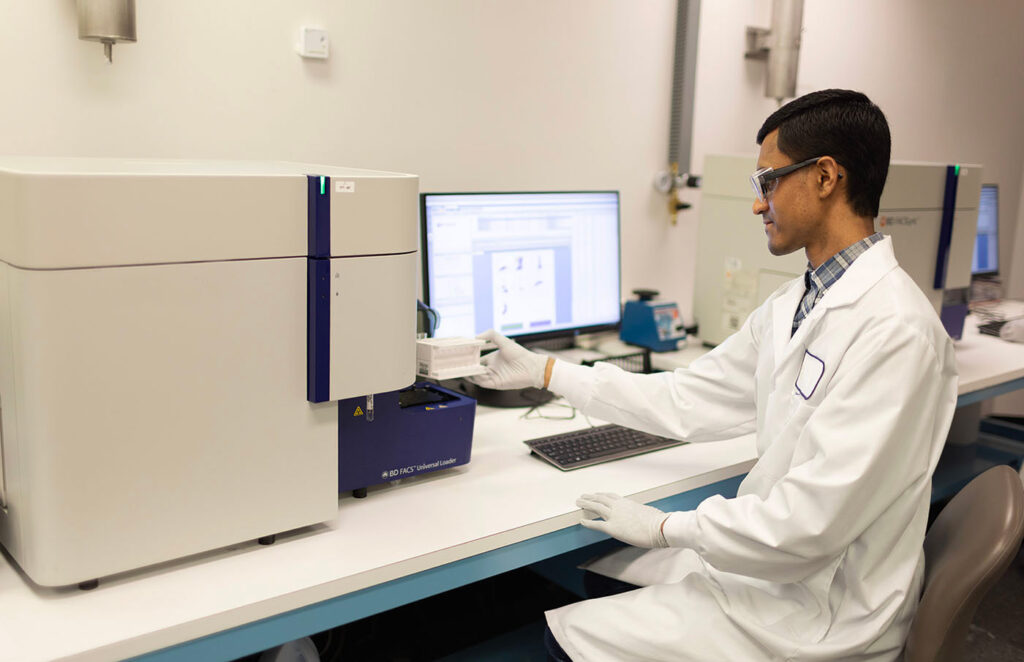Flow cytometry has become a key analytical technique in clinical trials. Through its multiparametric analysis, single-cell resolution, and high-throughput evaluation capabilities, flow cytometry can provide invaluable insights in therapeutic areas from autoimmunity and oncology to infectious diseases. One of the biggest challenges with the technique, however, is ensuring data consistency across laboratories in multi-center flow cytometry studies.
In such multi-center or global clinical trials, the use of different instruments and operators at each site introduces significant variability in flow cytometry readouts, making it challenging to compare results across locations. For drug developers, the lack of standardized data is both a logistical and a scientific hurdle. When results from different sites can’t be directly compared, it may lead to delays, increased costs, and the need for re-analysis or additional testing to achieve reliable data. Moreover, data variability compromises the reliability and reproducibility of results, undermining confidence in cross-site findings.
While some standardization efforts—such as shipping consistent reagents (antibodies and beads) to each site—can help align results, they are typically time-consuming, costly, and may only be partially effective. Even with consistent reagents, differences in staining protocols, instrument calibration, and operator technique can still result in variations, limiting researchers’ ability to achieve truly comparable data across study sites.
A novel method to align flow cytometry instruments
To address some of these challenges, we tested a robust, cost-efficient method for transferring a flow cytometry set-up across five different laboratories to achieve more consistent data.
First, polystyrene microbeads (BD™ CompBeads) were stained with a set of CD4 antibodies and then lyophilized (freeze-dried) to make them stable at room temperature for 18 months. The stable, pre-stained beads were then shipped to the five sites where we tested their consistency across the locations.
Once the beads arrived, each laboratory calibrated the bead to the target values on their harmonized instruments. Following this calibration, all instruments demonstrated similar performance characteristics (Figure 1), effectively creating a unified ‘fleet’ of instruments across locations.

Evaluation of reagent stability across sites
Following the initial set-up and harmonization process, we conducted tests to confirm the performance consistency of the lyophilized beads after resuspension. To do this, we tested reagent stability at different time points across two of the participating sites. The beads were kept in the dark and on ice, and mean fluorescence intensity (MFI) readings were taken at 15 mins, 30 mins, and then at 1, 2, 4, 6, 8, 24, and 48 hours after resuspension. For each time point across each fluorochrome, we calculated the change in fluorescent signal relative to the 15-minute reading, giving a percentage similarity (Table 1A).
To assess long-term stability, we conducted the same tests a year after the beads were shipped (Table 1B). During both the initial testing and the one-year follow-up, results indicated that, while most dyes remained stable after resuspension, some fluorochromes were less stable, and so were replaced with more robust alternatives. We replaced the dyes BB700, APC, and APC-R700 with RB705, Alexa-647, and Alexa Fluor®-700, respectively, to create a new kit. The updated kit supported stable signal acquisition for up to 8 hours post-resuspension, facilitating consistent and reproducible data collection across sites and time points (Table 1C).

Verification of shared assay alignment
While we achieved instrument harmonization across sites using lyophilized beads, further validation was needed to confirm such alignment is translated to assay performance on clinical specimens. To assess this, we aligned nine fluorescence parameters using the lyophilized beads, after which we tested the assay’s reproducibility by comparing 14 inter- and intra-site readouts from a reference sample with samples from three healthy donors.
Results indicated assay alignment, with readouts in the receiving laboratories having a coefficient of variation below our official criteria of 25% when compared to the reference laboratory, and a majority even below 10%. This level of consistency demonstrated successful assay alignment across all the active sites, as illustrated in Figure 2. These findings confirm that the harmonization achieved at the instrument level translated effectively into assay-level consistency, supporting cross-site data comparability.

A reliable, consistent, method for multi-site instrument alignment
Through the study, we showed that using lyophilized beads can enable multi-site instrument alignment. Overall, we found that this approach can deliver:
- Maintained data quality and reliability: the beads remained effective up to 48 hours post-resuspension and performed comparably even after a year, helping ensure stable data throughout clinical studies;
- Consistency across sites: the alignment of instruments and assays across sites standardized the analysis process, reducing data variability and allowing for more accurate data comparisons across locations;
- Cost and time savings: the 18-month stability of the beads helped reduce shipping requirements and recalibrations, which can help lower cost and administrative demands for more streamlined study workflows.
Overall, by employing pre-stained, lyophilized beads for flow cytometry instrument alignment, researchers can reduce inter-laboratory variability, supporting more consistent and reliable clinical research and enhancing the cost-effectiveness of flow cytometry in global clinical trials.
Dominic Gagnon is the associate director of global flow cytometry at CellCarta.



